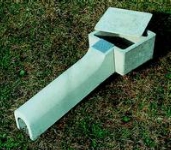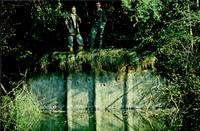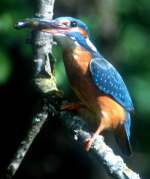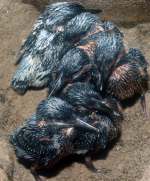Kingfisher and Sand Martin Nest Tunnel | |||
 [Pic. 1]: Nest Tunnel  [Pic. 2]: Example of installation  [Pic. 3]: Adult Kingfisher  [Pic. 4]: Young in the nesting chamber | The Kingfisher and Sand Martin have lost many of their natural nesting sites where streams and rivers have been diverted, restructured or otherwise 'improved'. Our Nest Tunnel provides a vital nesting opportunity in such places, and also on natural waterways where no suitable sites are available or where apparently suitable banks are too stony or have too many roots. This Tunnel was tested for decades and successfully used in many projects for rebuilding waterways all over Europe. Design: The floor of both the nest box and tunnel have a fine mesh grid to keep out rodents. The nesting chamber is protected with a removable lid for cleaning. Material: Lightweight concrete, air-permeable and able to compensate for temperature changes, thereby preventing the formation of condensation in the nesting chamber. The Nest Tunnel is supplied with detailed installation and maintenance instructions. Nesting habits: • Kingfisher: This "flying jewel" tends to use two different tunnels or tubes for its first and second brood. It is therefore advisable to put two Nest Tunnels in the same steep slope, keeping them at least 70 cm apart. • Sand Martin: Colonies of never less than 12 breeding pairs of Sand Martins congregate on natural moving water or on naturally formed cliffs, as well as in gravel and clay pits. Dimensions: • External dimensions of tunnel: Length 58 x height 15 x width 12.5 cm • Outer nesting chamber: 26 x 26 x height 17 cm • Inner nesting chamber: 22 x 22 x height 14 cm
| ||

Product overview
